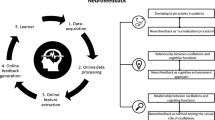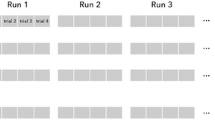Abstract
Behavioral and cognitive improvements in children with ADHD have been consistently reported after neurofeedback-treatment. However, neurofeedback has not been commonly accepted as a treatment for ADHD. This study addresses previous methodological shortcomings while comparing a neurofeedback-training of Theta-Beta frequencies and training of slow cortical potentials (SCPs). The study aimed at answering (a) whether patients were able to demonstrate learning of cortical self-regulation, (b) if treatment leads to an improvement in cognition and behavior and (c) if the two experimental groups differ in cognitive and behavioral outcome variables. SCP participants were trained to produce positive and negative SCP-shifts while the Theta/Beta participants were trained to suppress Theta (4–8 Hz) while increasing Beta (12–20 Hz). Participants were blind to group assignment. Assessment included potentially confounding variables. Each group was comprised of 19 children with ADHD (aged 8–13 years). The treatment procedure consisted of three phases of 10 sessions each. Both groups were able to intentionally regulate cortical activity and improved in attention and IQ. Parents and teachers reported significant behavioral and cognitive improvements. Clinical effects for both groups remained stable six months after treatment. Groups did not differ in behavioural or cognitive outcome.















Similar content being viewed by others
References
Alhambra, M. A., Fowler, T. P., & Alhambra, A. A. (1995). EEG Biofeedback: A new treatment option for ADD/ADHD. Journal of Neurotherapy, 2, 39–43.
Barbaresi, W., Katusic, S., Colligan, R., Weaver, A., Pankratz, V., Mrazek, D., et al. (2004). How common is attention-deficit/hyperactivity disorder? Towards resolution of the controversy: results from a population-based study. Acta Paediatrica, 445, 55–59.
Barbaresi, W. J., Katusic, S. K., Colligan, R. C., Pankratz, S., Weaver, A. L., Weber, K. J., et al. (2002). How common is attention-deficit/hyperactivity disorder? Archives of Pediatrics and Adolescent Medicine, 156, 217–224.
Beelmann, A., & Schneider, N. (2003). Wirksamkeit von Psychotherapie bei Kindern und Jugendlichen. Eine Übersicht und Meta-Analyse zum Bestand und zu Ergebnissen der deutschsprachigen Effektivitätsforschung. Zeitschrift für Klinische Psychologie und Psychotherapie, 32, 129–143.
Bortz, J., & Döring, N. (1995). Forschungsmethoden und evaluation für sozialwissenschaftler (2nd ed.). Berlin, Heidelberg: Springer.
Bruner, J. S. (1957). On perceptual readiness. Psychological Review, 64, 123–152.
Cohen, J. (1988). Statistical power analysis for the behavioral sciences. Hillsdale, NJ: Lawrence Erlbaum Associates.
Conners, C. K. (1997). Conner’ rating scales—revised; technical manual. North Tonawande, N.Y.: Multi-Health Systems.
Conners, C. K. (2002). Forty years of methylphenidate treatment in attention-deficit/hyperactivity disorder. Journal of Attention Disorders, 6, 17–30.
Döpfner, M., & Lehmkuhl, G. (2002). Evidenzbasierte Therapie von Kindern und Jugendlichen mit Aufmerksamkeitsdefizit-/Hyperaktivitätsstörung (ADHS). Prax Kinderpsychol Kinderpsychiat, 51, 419–440.
Eyberg, S. M., & Pincus D. (1999). Eyberg child behavior inventory & sutter-eyberg student behavior inventory—Revised. Odessa, FL: Psychological Assessment Ressources.
Fuchs, T., Birbaumer, N., Lutzenberger, W., Gruzelier, J. H., & Kaiser, J. (2003). Neurofeedback treatment for attention-deficit/ hyperactivity disorder in children: A comparison with methylphenidate. Applied Psychophysiology and Biofeedback, 28, 1–12.
Goldman, L. S., Genel, M., Bezman, R. J., & Slanetz, P. J. (1998). Diagnosis and treatment of attention-deficit/hyperactivity disorder in children and adolescents. Journal of the American Medical Association, 279, 1100–1107.
Heinrich, H. (2004). Training of slow cortical potentials in ADHD: Evidence for positive behavioral and neurophysiological effects. Biological Psychiatry, 55, 772–775.
Higgins, E. T., & Rholes, W. S. (1977). Category accessibility and impression formation. Journal of Experimental Social Psychology, 13, 141–154.
Hinterberger, T., Kotchoubey, B., Kaiser, J., Kübler, A., Neumann, N., Perelmouter, J., et al. (2000). Anwendungen der Selbstkontrolle langsamer kortikaler Potentiale. Verhaltenstherapie, 10, 219–227.
Hinterberger, T., Neumann, N., Pham, M., Kubler, A., Grether, A., Hofmayer, N., et al. (2004). A multimodal brain-based feedback and communication system. Experimental Brain Research, 154, 521–526.
Johnstone, S. J., Barry, R. J., & Anderson, J. W (2001). Topographic distribution and developmental time course of auditory event-related potentials in two subtypes of attention-deficit hyperactivity disorder. International Journal of Psychophysiology, 42, 73–94.
Kotchoubey, B., Blankenhorn, V., Fröscher, W., Strehl, U., & Birbaumer, N. (1997). Stability of cortical self-regulation in epilepsy patients. Neuroreport, 8, 1867–1870.
Kotchoubey, B., Strehl, U., Uhlmann, C., Holzapfel, S., König, M., Fröscher, W., et al. (2001). Modification of slow cortical potentials in patients with refractory epilepsy. Epilepsia, 42, 406–416.
Rossiter, T. R., & La Vaque, T. J. (1995). A comparison of EEG biofeedback and psychostimulants in treating attention deficit hyperactivity disorder. Journal of Neurotherapy, 1, 48–59.
Lubar, J. F., & Shouse, M. N. (1976). EEG and behavioral changes in a hyperkinetic child concurrent with training of the sensorimotor rhythm (SMR). A preliminary report. Biofeedback and Self-Regulation, 1, 293–306.
Lubar, J. F., Swartwood, M. O., Swartwood, J. N., & O’Donnell, P. H. (1995). Evaluation of the effectiveness of EEG neurofeedback training for ADHD in a clinical setting as measured by changes in TOVA scores, behavioral ratings and WISCR performance. Biofeedback and Self- Regulation, 20, 83–99.
Lubar, J. O., & Lubar, J. F. (1984). Electroencephalographic biofeedback of SMR and Beta for treatment of attention deficit disorders in a clinical setting. Biofeedback and Self-Regulation, 9, 1–23.
Mann, C. A., Lubar, J. F., Zimmerman, A. W., Miller, C. A., & Muenchen, R. A. (1992). Quantitative analysis of EEG in boys with ADHD: controlled study with clinical implications. Pediatric Neurology, 8, 30–36.
Miller, Y. (2000). Erziehung von Kindern im Kindergartenalter. Erziehungsverhalten und Kompetenzüberzeugungen von Eltern und der Zusammenhang zu kindlichen Verhaltensstörungen. Doktorarbeit an der TU Braunschweig. (un pub).
Monastra, V. J., Linden, M., VanDeusen, P., Green, G., Wing, W., Phillips, A., et al. (1999). Assessing attention deficit hyperactivity disorder via quantitative electrencephalography. Neurophysiology, 13, 424–433.
Monastra, V. J., & Lubar, J. F. L. M. (2001). The development of a quantitative electroencephalographic scanning process for attention deficit—Hyperactivity disorder reliability and validity studies. Neuropsychology, 15, 136–144.
Monastra, V. J., Monastra, D. M., & George, S. (2002). The effects of stimulant therapy, EEG biofeedback, and parenting style on the primary smptoms of attention-deficit/Hyperactivity disorder. Applied Psychophysiology and Biofeedback, 27, 231–249.
Monastra, V. J., Lynn, S., Linden, M., Lubar, J. F., Gruzelier, J., & La Vaque, T. J. (2005). Electroencephalographic biofeedback in the treatment of attention-deficit/Hyperactivity disorder. Applied Psychophysiology and Biofeedback, 30, 95–114.
MTA Cooperative Group. (2004). National institute of mental health multimodal treatment study of ADHD follow-up: Changes in effectiveness and growth after the end of treatment. Pediatrics, 113, 762–769.
Neumann, N., Hinterberger, T., Kaiser, J., Leins, U., Birbaumer, N., & Kübler, A. (2004). Automatic processing of self-regulation of slow cortical potentials: evidence from brain-computer communication in paralyzed patients. Clinical Neurophysiology, 115, 628–635.
Othmer, S., Othmer, S. F., & Clifford, S. M. (1991). EEG biofeedback training for attention deficit disorder, specific learning disabilities, and associated conduct problems. EEG Spectrum (http://www.eegspectrum.com/Applications/ADHD-ADD/).
Ramirez, P. M., Desantis, D., & Opler, L. A. (2001). EEG biofeedback treatment of ADD. A viable alternative to traditional medical intervention? Annals of the New York Academy of Science, 931, 342–358.
Rockstroh, B., Elbert, T., Canavan, A., Lutzenberger, W., & Birbaumer, N. (1989). Slow cortical potentials and behavior. Baltimore, München, Wien: Urban & Schwarzenberg.
Rockstroh, B., Elbert, T., Lutzenberger, W., & Birbaumer, N. (1990). Biofeedback: Evaluation and therapy in children with attentional dysfunctions. In A. Rothenberger (Ed.), Brain and behavior in child psychiatry (pp. 345–355). Berlin: Springer.
Satterfield, J. H., Schell, A. M., & Nicholas, T. (1994). Preferential neural processing of attended stimuli in attention-deficit hyperactivity disorder and normal boys. Psychophysiology, 31, 1–10.
Schachter, M., Pham, B., King, J., Langford, S., & Moher, D. (2001). How efficacious and safe ist short-acting methylphenidate for the treatment of attention-deficit disorder in children and adolsecents? A meta-analysis. Canadian Medical Association, 165, 1475–1488.
Shouse, M. N., & Lubar, J. F. (1979). Operant conditioning of EEG rhythms and ritalin in the treatment of hyperkinesis. Biofeedback and Self- Regulation, 4, 299–312.
Spencer, T. J., Biederman, J., Wilens, T. E., & Faraone, S. V. (2002). Novel treatments for ADHD in children. Journal of Clinical Psychiatry, 63, 16–22.
Spencer, T., Biederman, J., Wilens, T., Harding, M., O’Donnell, D., & Griffin, S. (1996). Pharmacotherapy of attention-deficit hyperactivity disorder across the life. Journal of the American Academy of Child and Adolescent, 35, 409–432.
Strehl, U., Leins, U., Goth, G., Klinger, C., & Birbaumer, N. (2006). Physiological regulation of slow cortical potentials—a new treatment for children for ADHD. Pediatrics.
Tansey, M. A., & Bruner, R. L. (1983). EMG and EEG biofeedback training in the treatment of a 10-year-old hyperactive boy with a developmental reading disorder. Biofeedback and Self- Regulation, 8, 25–37.
Tewes, U., Rossmann, P., & Schallberger, U. (1999). Hamburg wechsler intelligenztest für kinder—Dritte Auflage (HAWIK III). Bern: Huber.
Thompson, L., & Thompson, M. (1998). Neurofeedback combined with training in meta cognitive strategies: Effectiveness in students with ADD. Applied Psychophysiology and Biofeedback, 23, 243–263.
Vernon, D., Frick, A., & Gruzelier, J. (2004). Neurofeedback as a treatment for ADHD: A methodological review with implications for future research. Journal of Neurotherapy, 8, 53–82.
Wagner, K. D. (2002). Management of treatment refractory attention-deficit/hyperacitivity disorder in children and adolescents. Psychopharmacology-Bulletin, 36, 130–142.
Zimmermann, P., & Fimm, B. (1997). Testbatterie zur aufmerksamkeitsprüfung (TAP), Version 1.7. Herzogenrath: PsyTest.
Acknowledgments
This study was supported by the Förderprogramm der Medizinischen Fakultät Tübingen zur Angewandten Klinischen Forschung (AKF-Programm) and the Deutsche Forschungsgemeinschaft (DFG).
Author information
Authors and Affiliations
Corresponding author
Rights and permissions
About this article
Cite this article
Leins, U., Goth, G., Hinterberger, T. et al. Neurofeedback for Children with ADHD: A Comparison of SCP and Theta/Beta Protocols. Appl Psychophysiol Biofeedback 32, 73–88 (2007). https://doi.org/10.1007/s10484-007-9031-0
Received:
Accepted:
Published:
Issue Date:
DOI: https://doi.org/10.1007/s10484-007-9031-0




